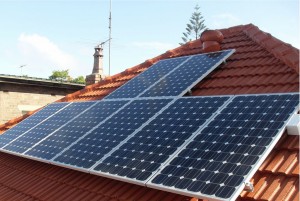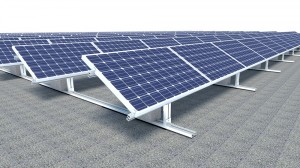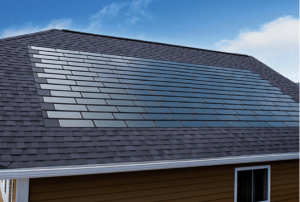Sloped roof mounting systems
When it comes to residential solar installations, solar panels are often found on sloped rooftops. There are many mounting system options for these angled roofs, with the most common being railed, rail-less and shared rail. All of these systems require some type of penetration or anchoring into the roof, whether that’s attaching to rafters or directly to the decking.
The standard residential system uses rails attached to the roof to support rows of solar panels. Each panel, usually positioned vertically/portrait-style, attaches to two rails with clamps. The rails secure to the roof by a type of bolt or screw, with flashing installed around/over the hole for a watertight seal.
Rail-less systems are self-explanatory—instead of attaching to rails, solar panels attach directly to hardware connected to the bolts/screws going into the roof. The module’s frame is essentially considered the rail. Rail-less systems still need the same number of attachments into the roof as a railed system, but removing the rails reduces manufacturing and shipping costs, and having fewer components speeds up install time. Panels are not limited to the direction of rigid rails and can be positioned in any orientation with a rail-free system.
Shared-rail systems take two rows of solar panels normally attached to four rails and removes one rail, clamping the two rows of panels on a shared middle rail. Fewer roof penetrations are needed in shared-rail systems, since one entire length of rail (or more) is removed. Panels can be positioned in any orientation, and once accurate positioning of the rails is determined, installation is quick.
Once thought to be impossible on sloped roofs, ballasted and non-penetrating mounting systems are gaining traction. These systems are essentially draped over the peak of a roof, distributing the system’s weight on both sides of the roof.
Strain-based loading keeps the array almost suctioned to the roof. Ballast (usually small concrete pavers) might still be needed to hold the system down, and that extra weight is positioned overtop load-bearing walls. With no penetrations, installation can be incredibly quick.
Flat roof mounting systems
Commercial and industrial solar applications are often found on large flat rooftops, like on big-box stores or manufacturing plants. These roofs may still have a slight tilt but not nearly as much as sloped residential roofs. Solar mounting systems for flat roofs are commonly ballasted with few penetrations.
Since they’re positioned on a large, level surface, flat roof mounting systems can install relatively easily and benefit from pre-assembly. Most ballasted mounting systems for flat roofs use a “foot” as the base assembly—a basket- or tray-like piece of hardware with a tilted design that sits on top of the roof, holding ballast blocks in the bottom and panels along its top and bottom edges. Panels are tilted at the best angle to capture the most sunlight, usually between 5 and 15°. The amount of ballast needed is dependent on a roof’s load limit. When a roof can’t support a lot of extra weight, some penetrations may be needed. Panels attach to the mounting systems either through clamps or clips.
On large flat roofs, panels are best positioned facing south, but when that’s not possible, solar power can still be generated in east-west configurations. Many flat roof mounting system manufacturers also have east-west or dual-tilt systems. East-west systems are installed just like south-facing ballasted roof mounts, except the systems are turned 90° and panels butt-up to one another, giving the system a dual-tilt. More modules fit on a roof since there is less spacing between rows.
Flat roof mounting systems come in a variety of makeups. While aluminum and stainless steel systems do still have a home on flat roofs, many plastic- and polymer-based systems are popular. Their light weight and moldable designs make installation quick and easy.
Solar shingles and BIPV
As the general public becomes more interested in aesthetics and unique solar installations, solar shingles will rise in popularity. Solar shingles are part of the building-integrated PV (BIPV) family, meaning that solar is built-in to the structure. No mounting systems are needed for these solar products because the product is integrated into the roof, becoming part of the roofing structure.
Post time: Dec-03-2021



